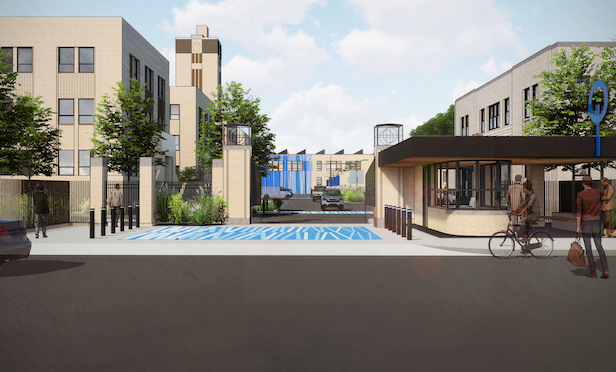 An extensive redevelopment is planned for The Quartermaster campus in the Girard Estate section of Philadelphia.
An extensive redevelopment is planned for The Quartermaster campus in the Girard Estate section of Philadelphia.
PHILADELPHIA—The owner of the Quartermaster campus in South Philadelphia has retained Colliers International as the exclusive agent for the available office/flex space at the six-building property that is currently being redeveloped.
Quartermaster owner Sky Management has partnered with architecture firm Digsau and is currently implementing a host of capital improvements that are expected to be completed by the spring of 2020. Among the upgrades include: substantial greening, hardscaping and artistic improvements along the central avenue; a complete renovation of the gatehouse as a modern design center, event and meeting space and reconceiving the Sycamore Grove with design-forward lighting and furniture to create a comfortable and collaborative outdoor environment.
"With newly activated outdoor areas for community events, a fitness center, and on-site parking, we have a truly unique offering within the City of Philadelphia." says Elizabeth Morrow, VP of Colliers, who along with SVP Ina Sargen are responsible for leasing at the project.
Other improvements expected to be completed shortly include what Colliers terms as a "substantial investment" in modern LED lighting illuminating the storied Clocktower. Request for proposals to the art community related to custom murals and installations are anticipated to be distributed later this year.
This storied campus is home to Homeland Security's Delaware Valley Intelligence Center and the U.S. Department of Labor's Regional Job Corps Training Center.
The Philadelphia Quartermaster Depot, an expansion of the Schuylkill Arsenal dating back to the early 1800's, was built at its current location in 1918. It went on to be the largest purchaser and maker of textile products in the world and likened to a "little Pentagon." Its historically significant art deco buildings and central clocktower designed by Ballinger sit at the heart of the complex that was supported by its own railroad system, police and fire protection. At the height of wartime efforts, the depot employed up to 15,000 Philadelphians.
© 2025 ALM Global, LLC, All Rights Reserved. Request academic re-use from www.copyright.com. All other uses, submit a request to [email protected]. For more information visit Asset & Logo Licensing.








